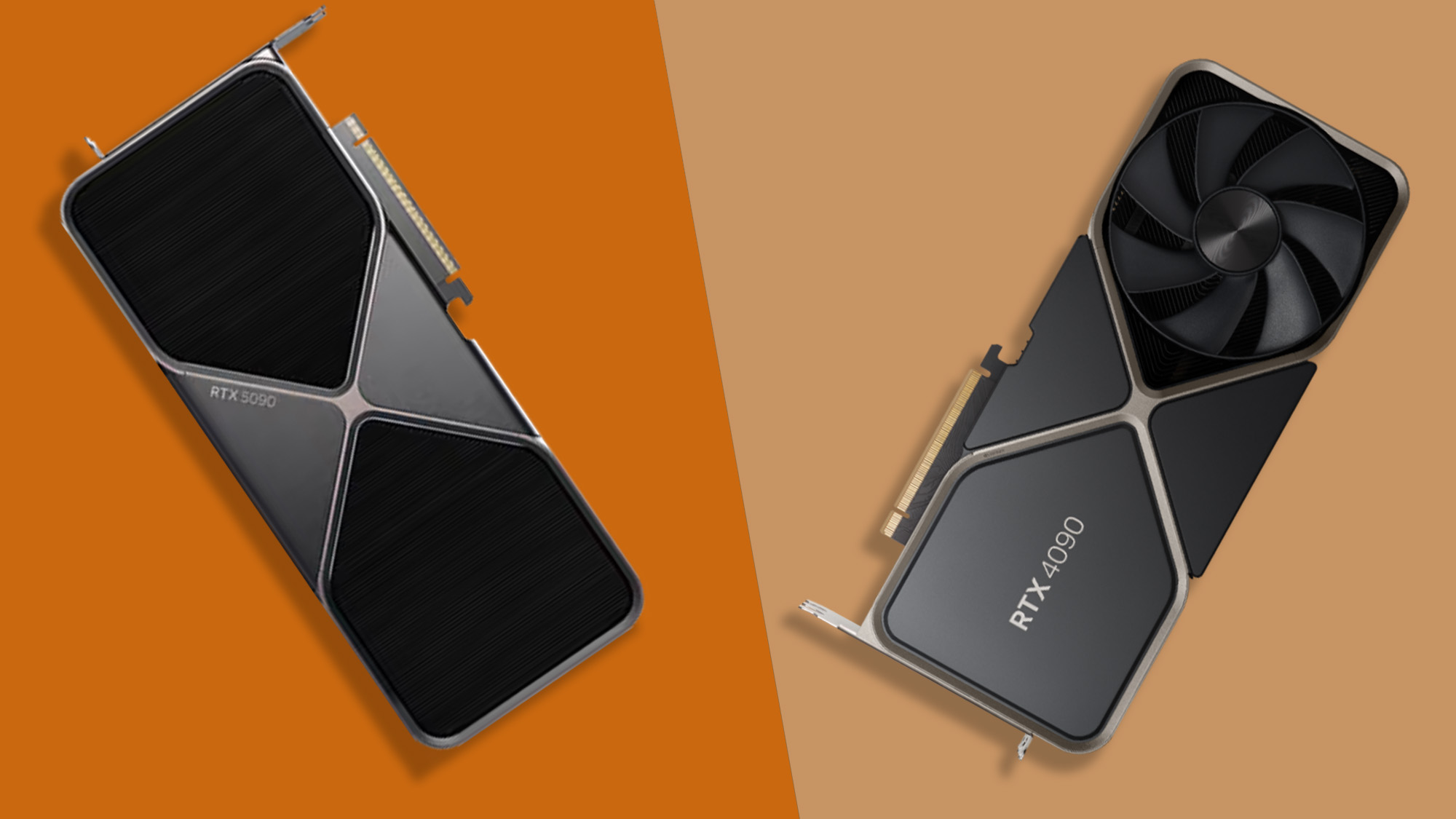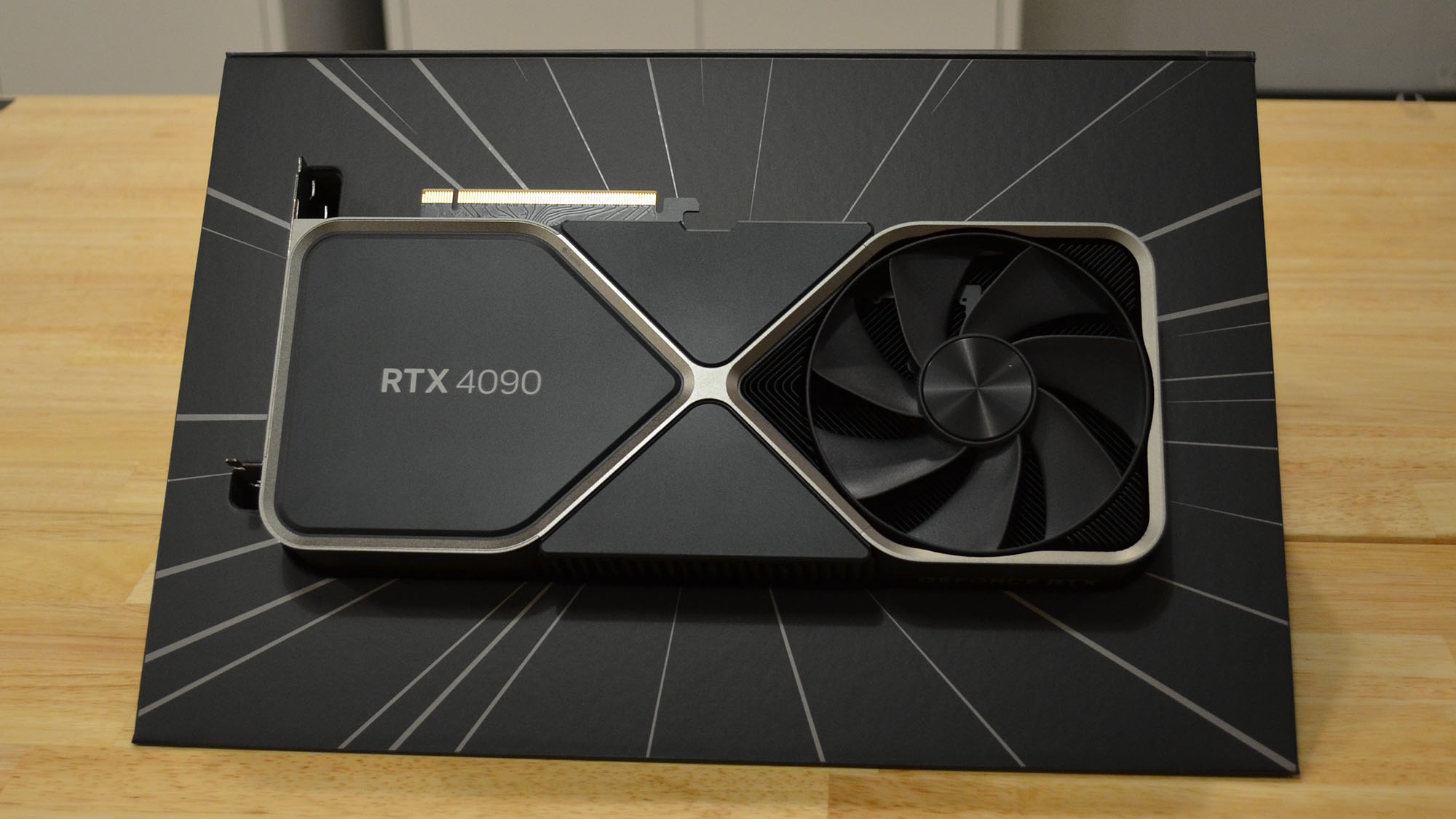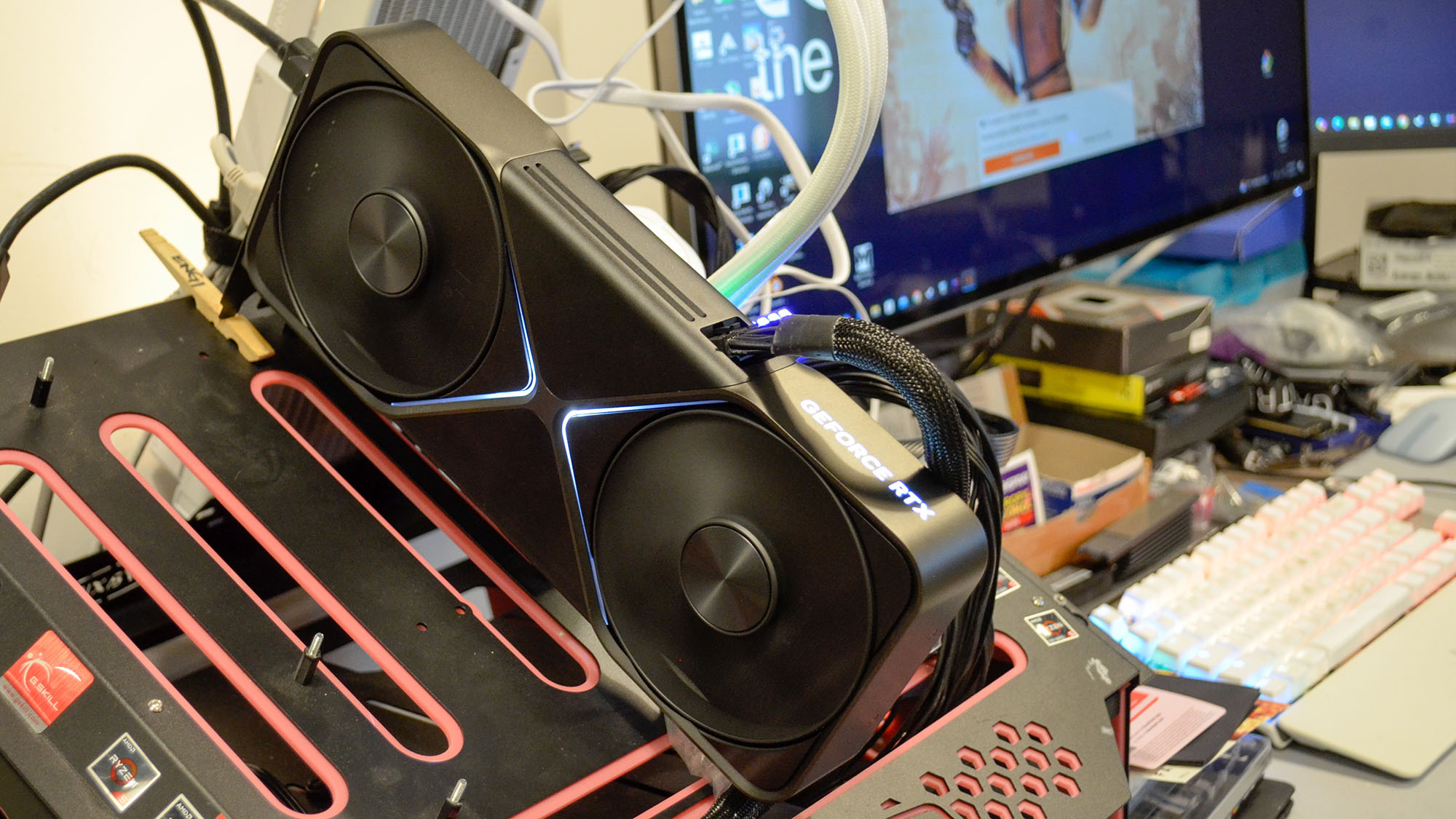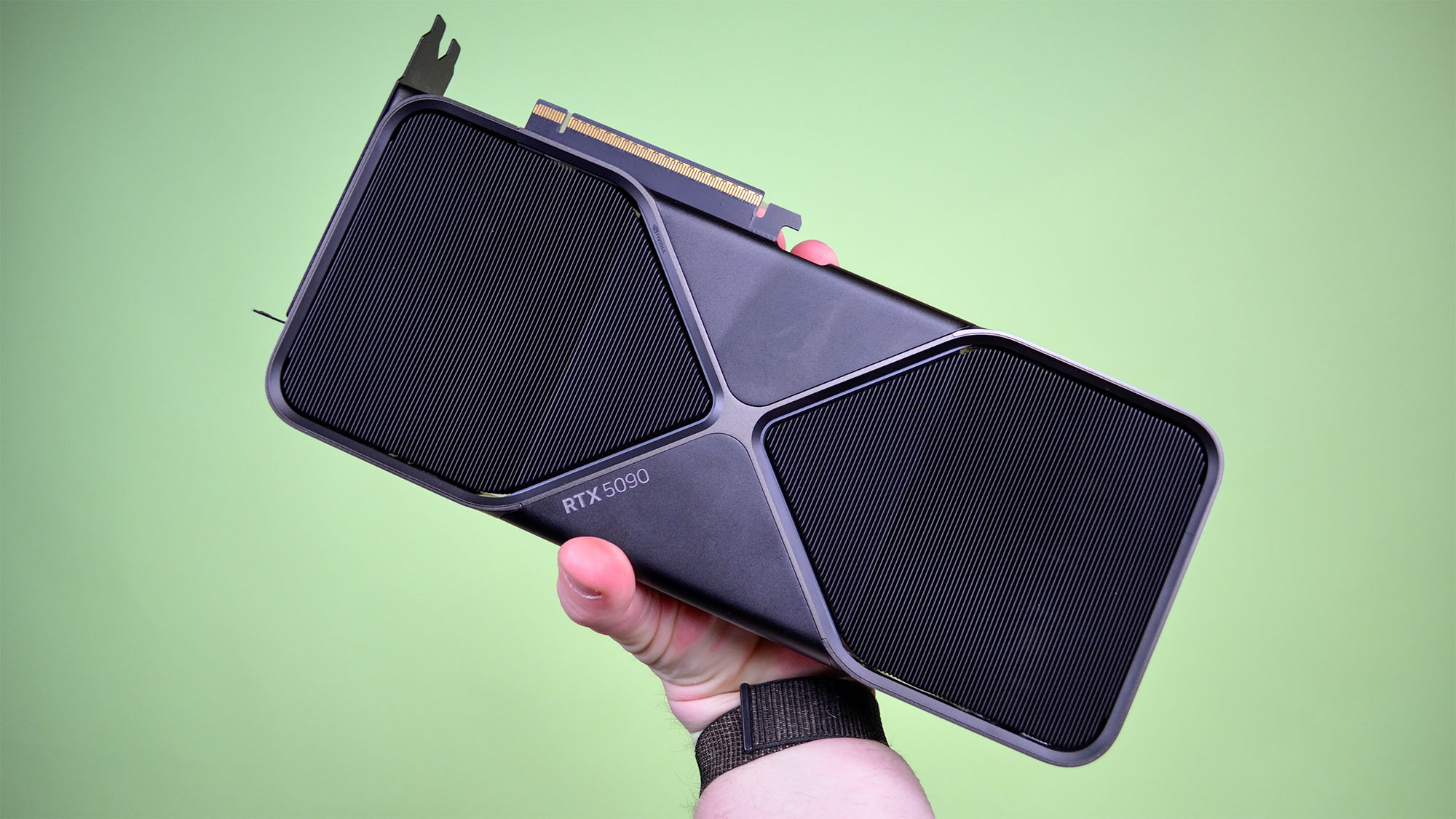
Compute Units: 170
Shaders: 21,760
Ray processors: 170
AI/Tensor processors: 680
Boost clock: 2,407 MHz
Memory type: GDDR7
Memory pool: 32 GB
Memory speed (effective): 28 Gbps
Memory bandwidth: 1,790 GB/s
Bus interface: 512-bit
TGP: 575W
Power connector: 1 x 16-pin
Slot width: Dual
For
- Best-in-market performance
- Gaming in 8K is actually possible, even without DLSS 4
- DLSS 4 is remarkable
- Excellent dual-slot design
- Finally, a PCIe 5.0 GPU
Against
- Ludicrously expensive
- An absolute glutton for wattage
- Overkill?
- You'll need to have a premium gaming PC setup to really take advantage of this card
Compute Units: 128
Shaders: 16,384
Ray processors: 128
AI/Tensor processors: 512
Boost clock: 2,520 MHz
Memory type: GDDR6X
Memory pool: 24 GB
Memory speed (effective): 21 Gbps
Memory bandwidth: 1,010 GB/s
Bus interface: 384-bit
TGP: 450W
Power connector: 1 x 16-pin
Slot width: Triple
For
- Jaw-dropping performance
- DLSS 3 is game changing
- Creatives will absolutely love it
- Outstanding value for a luxury card
Against
- Still very expensive
- 16-pin connector will test cable management skills
- RTX 4080 Super and RX 7900 XTX a better bet for gamers
With the launch of the Nvidia GeForce RTX 5090 on January 30, 2025, gamers, creatives, and all-around computing enthusiasts have a new flagship Nvidia card to put on their wishlist, and it's easy to see why.
The Nvidia RTX 5090 is easily the best graphics card on the market right now, offering fantastic performance for gaming, creating, and AI workloads that few other cards can compete with. There is one card that can hold its own against Nvidia's latest high-end card, and that's Nvidia's last-gen flagship, the Nvidia GeForce RTX 4090.
While stock for the RTX 4090 is expected to become more scarce now that the RTX 5090 is on the scene, that doesn't mean that it's disappeared entirely, and for a lot of folks, the RTX 4090 might be the better option, especially if demand for the RTX 5090 forces the price of the RTX 4090 down from the ridiculously inflated heights we've seen pretty much since it launched.
So which of the two Nvidia graphics cards are the best bet for your needs and budget? Fortunately, I've extensively tested both cards and I'm here to guide you through your decision backed by data and my own experience with the two cards so you can buy the graphics card that's right for you.
Nvidia RTX 5090 vs RTX 4090: Price

So there are a couple of caveats when discussing the price of the RTX 5090 vs RTX 4090, and that's how prices for the best Nvidia graphics cards have been all over the place in recent years.
For the record, the MSRP of the RTX 5090 is $1,999 / £1,939 / AU$4,039 for the Founders Edition cards from Nvidia, and $1,599 £1,679 / AU$2,959 for the Founders Edition RTX 4090 cards released back in October 2022.
Almost immediately the RTX 4090 started selling for a 50% premium or more, depending on the card and seller, and that's not even factoring in the MSRPs of the various third-party cards from Nvidia partners like PNY, MSI, Asus, Gigabyte, and others. Prices for these cards have shot above the $2,000 / £2,000 / AU$4,000 mark and have stayed there pretty much since the RTX 4090's release.
But while it might look like the RTX 5090 and RTX 4090 are selling for the same price, the RTX 5090 is also going to face the exact same kind of upward price pressure as the RTX 4090, and so you definitely shouldn't expect to find many Nvidia RTX 5090 cards to sell at its MSRP.
That means that, ultimately, the RTX 5090 will still be more expensive than the RTX 4090, and by a fairly substantial amount, making the RTX 4090 an attractive option if you're not willing to pay the exorbinant markups the RTX 5090 will be experiencing for the forseeable future.
- Winner: Nvidia RTX 4090
Nvidia RTX 5090 vs RTX 4090: Specs

Given that it's the latest flagship graphics card from Nvidia, it goes without saying that the RTX 5090 has a spec advantage over the older RTX 4090, but it's advantage goes beyond just an increase in core counts or more memory.
The two biggest things to know about the RTX 5090 vis a vis its specs is that it is the first consumer GPU to use cutting-edge GDDR7 VRAM, as well as the new PCIe 5.0 GPU interface, both of which mean faster data throughput for some pretty critical funtions.
Of the two, GDDR7 is easily the most important, as this substantially increases the memory bandwidth of the RTX 5090 over the RTX 4090, meaning faster texture processing while gaming at higher resolutions (which directly translates into faster framerates), as well as opening up the possibility of serious 8K gaming down the road once 8K monitors go mainstream.
The RTX 4090, meanwhile, still uses the slower PCIe 4.0 interface and GDDR6X VRAM, so while these are sufficient for 4K gaming, you may hit a ceiling when it comes to memory long before the RTX 5090 does. If you want a futureproofed card, the RTX 5090 is the way to go.
Also worth noting is that the RTX 5090 has introduced a new thermal design for the Founders Edition card that utilizes dual flow-through, meaning that there are two fans pushing cooler air over the GPU's heatsink fins, giving it better cooling than the RTX 4090.
That extra cooling is pretty much eaten up entirely by the new 575W TDP for the RTX 5090, compared to the still excessive, but less so, 450W TDP for the RTX 4090. You're also going to need to do something with all that heat being blown off the card, so you'll need to consider the airflow situation in your case when using the RTX 5090.
Still, those caveats can't take away from the next-gen specs in the RTX 5090, making it a card you can feel comfortable will go the distance should you decide to buy it.
- Winner: Nvidia RTX 5090
Nvidia RTX 5090 vs RTX 4090: Performance

Ultimately, if you're investing in either of these cards, you're definitely looking for the best performance possible for your money. Fortunately, both cards are seriously powerful GPUs, and there really aren't any others in their class.
But ont card consistently comes out ahead in my benchmark testing, and the results shouldn't be very surprising.
Starting with synthetic benchmarks, the RTX 5090 nearly sweeps the entire synthetic benchmark battery, losing out to the RTX 4090 in only one test, 3DMark Night Raid, and even that might be more of a fluke than anything. Overall though, the RTX 5090 comes in about 21% faster than the RTX 4090 during synthetic testing, so it's off to a good start.
When it comes to creative workloads, the RTX 5090 also comes out the overall winner, though that is almost entirely down to its dominating performance in 3D model rendering, as measured by Blender Benchmark 4.30.
On the video editing side, there's not much difference between the two cards, but that may change as better processors are released, as both cards are outpacing what the CPU can manage at this point.
As for photo editing and graphic design work, the tool I use to measure this, the PugetBench for Creators Adobe Photoshop benchmark, kept crashing during testing, so I wasn't able to get any definitive data on this front, but once the software is updated, I'll try again and update these charts with that data once I have it.
On the gaming side of things, as you'd expect, the Nvidia RTX 5090 is an absolute beast, chewing through 1440p gaming without much trouble, as does the RTX 4090. But the RTX 5090 manages a roughly 20% faster average 1440p frame rate while gaming for both average fps and minimum/1% fps. Turn on ray tracing (without upscaling), and you can expect 23-26% better gaming performance from the RTX 5090. Basic DLSS 3 upscaling on balanced (so no frame generation) will get you between 14-23% faster performance on the RTX 5090 than the RTX 4090, depending on whether you use ray tracing as well.
But where the RTX 5090 really shines is its 4K gaming performance. Thanks to that faster GDDR7 memory and wider memory bus, 4K textures fly through the pipeline, boosting framerates considerably over the RTX 4090 by about 26% for average fps, and nearly 29% on average for minimum/1% fps. The RTX 5090's ray tracing performance at 4K is also exceptional, getting about 34% faster average framerates overall.
And none of this even factors in DLSS 4 with Multi-Frame Generation, which you can expect to substantially boost the numbers for the RTX 5090 (you can check out Matt Hanson's DLSS 4 deep dive that explains how much of a difference you can expect to see in your favorite games).
Overall, then, there really is no contest on the performance front, with the RTX 5090 scoring decisive win after decisive win. The RTX 4090 certainly isn't a slough compared to the rest of the graphics card market, but the RTX 5090 is simply out ahead on its own, performance-wise.
- Winner: Nvidia RTX 5090
Nvidia RTX 5090 vs RTX 4090: Final Verdict

So, which one should you buy?
Considering that you're going to be spending a fortune on either one of these cards, I'd recommend going for the RTX 5090. Yes, it's more expensive, but the advanced features and specs make for better future proofing, and the performance gains gen-on-gen more than justify the investment.
That doesn't mean you should ignore the RTX 4090, however, especially if its price comes down in the coming weeks and months now that the RTX 5090 is on the scene. If you can get it for a bargain, you should definitely consider the RTX 4090, but barring that, there's no beating the RTX 5090.







